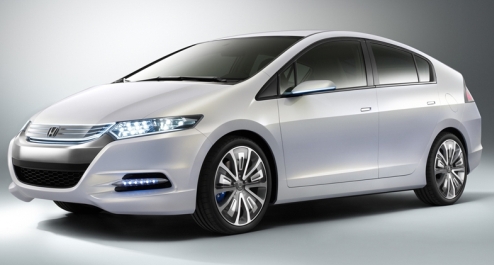The next generation Kia Optima is set to make its world premiere at the 2010 New York International Auto Show. "The next generation of Kia Optima possesses the power to surprise," says Peter Schreyer, Kia's Chief Design Officer. "It's a car that people will simply not expect from Kia - and that's exactly what we set out to achieve." Kia has officially unveiled the next Optima four-door coupe, ahead of the full reveal set to take place at the 2010 New York Auto Show. Kia’s new flagship sedan/coupe looks to be a far more attractive and far more worthy of a flagship designation.
2011 Kia Optima
Just weeks ago Kia released new sketches of the upcoming 2011 Magentis four-door coupe – currently known as the Optima sedan in America. The sketches look to be very true to the now official images that have been released ahead of the full reveal set for the upcoming 2010 New York Auto Show. The saloon exudes an athletic confidence from every angle - its raked roofline, high and pronounced shoulder line of its sculpted flanks and its extended wheelbase are complemented by flared wheelarches and a shallow glasshouse that create a saloon with a muscular, self-assured stance. The striking visage of the car features a new interpretation of Kia's bold 'tiger' family face that's edged by piercing projector headlamps.
2011 Kia Optima
The Kia Optima is currently the flagship sedan for the automaker and the next model gains considerable changes in the exterior cosmetics department. The outgoing Optima is a fairly tame sedan, but Kia is replacing its sedan with a much sportier silhouette – much more akin to a coupe, than a sedan. So much so, Kia says the 2011 Optima will be labeled as a 4-door coupe, rather than a sedan. Following the theme of recent model revisions, new Kia Optima is longer, lower and wider than before, the Kia's coupe-like profile is enhanced by the sweeping chrome arc that flows from A to C pillar, a distinctive design motif that visually lowers the car further still and enhances its cab-backwards proportions.
2011 Kia Optima
In addition to significantly overhauling the overall styling direction of the Magentis/Optima, Kia says that it will be bringing its next flagship sedan/coupe closer to the ground with a lower stance, in addition to giving it a wider and more stable stance to go long with its longer wheelbase. Kia says the end result is a four-door coupe that has more room for its occupants and cargo alike, as well as a more planted driving dynamic. "For this car we started with a clean sheet and worked to achieve an exterior design with a European feeling and stance," explains Gregory Guillaume, Chief Designer, Kia Europe. To help achieve this, the exterior was designed by his team in Frankfurt. The interior was created by the design team in California.
2011 Kia Optima
Power-wise, the Optima will use the same engines as the 2011 Sonata and will be offered in four and six-cylinder versions. The four-cylinder offering, should it come from the 2011 Sonata, will be a 2.4-liter good for 200 horsepower and 186 lb.-ft of torque – all the while getting as much as 35 miles per gallon on the highway. The new D-segment offering is spacious, and with class-leading levels of safety and luxury equipment, the intelligently configured and driver-oriented cabin underlines a newfound poise and presence. "This new model embodies Kia's confident new design direction," says Schreyer. "It's a global car with individual appeal."
The 2011 Kia Optima is expected to hit the market in the fall of 2010, with a hybrid version possibly available at lunch, or relatively soon after.
-4.gif)

-3.gif)
-2.gif)
-5.gif)


























 Toyota Hybrid Car
Toyota Hybrid Car




